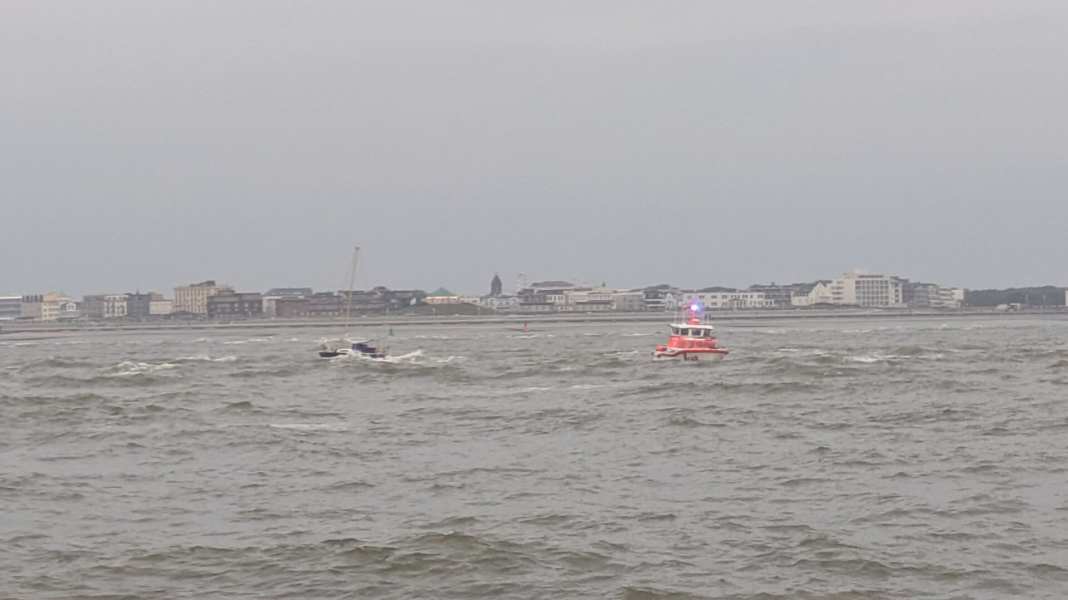
Two sailors were rescued from extreme distress in a dramatic rescue operation off Norderney at the weekend. At around 6.30 p.m., the men alerted the Maritime Rescue Coordination Centre (MRCC) Bremen, which is operated by the DGzRS. They had run aground shortly after low tide in their seven-metre-long sailing boat in the Seegatt Schluchter, around one kilometre west of the island of Norderney. The dangerous situation quickly developed into a life-threatening drama when the boat became a plaything of the surf as the tide rose. Waves up to one and a half metres high repeatedly lifted the sailing boat and caused it to crash heavily onto the hard sandy bottom.
Dramatic scenes in the surf zone
The situation of the two sailors was extremely critical. Their boat was in danger of breaking apart in the surf zone, while they themselves had to survive the constant violent grounding. To make matters worse, the wind and swell were pushing the small boat towards the coast - into the dreaded Legerwall situationThe crew was unable to free the ship from the dangerous situation under its own power. At the time, a south-westerly wind of force 4 to 5 Beaufort prevailed in the sea off Norderney. The rising tide also contributed to pushing the boat higher onto the sandbank.
Challenging rescue operation
As soon as the distress call was received, the sea rescuers from the Norderney station set course for the distressed vessel with a rescue cruiser and a rescue boat. The rescue operation proved to be extremely challenging. Using the particularly shallow-draft lifeboat "Woltera", the sea rescuers tried to get as close as possible to the sailing boat in order to establish a line connection. This task proved to be a major challenge in view of the adverse conditions. The rescue boat itself had to survive heavy grounding in the surf on the sandbank - a risk for which the DGzRS's extremely seaworthy rescue units are specially designed. The rescuers had to manoeuvre particularly carefully to avoid getting stuck themselves. Despite all the difficulties, they finally managed to hand over a towline to the distressed vessel and make the crucial connection.
Successful rescue despite water ingress
After the line was successfully connected, the "Woltera" initially towed the sailing boat into deeper water. There, the rescue cruiser "Eugen" took over the distressed vessel and took it alongside. The dramatic experiences of the two sailors were clearly noticeable - one of them had apparently also become seasick. When they took over, the sea rescuers realised that the boat had taken on water and was in danger of sinking. The powerful bilge pumps of the rescue cruiser were deployed immediately and managed to bring the water ingress under control. The rescuers then brought the sailing boat safely into the harbour of Norderney, where they handed the seasick sailor over to the rescue service ashore for further treatment. Due to the heavy water ingress, the sailing boat was put ashore by local companies.
Dangerous sea races off the East Frisian Islands
The incident is one of a series of accidents in the shipping lanes off the East Frisian Islands. These passages between the islands are considered extremely challenging, even by experienced sailors. Precise navigation is required as the fairways lead past dangerous sandbanks. Stranding in this area is extremely dangerous for the ship and crew. Particularly treacherous: due to natural dynamic processes, the fairways can shift constantly, which is why it is essential to obtain up-to-date information on the situation before approaching the sea lanes. It was only in April of this year that a family of six had to be rescued from a similar situation, when their nine-metre-long sailing yacht got stuck on a large sandbank between the Schluchter and Dovetief fairways north of Norderney.
Wadden fairway closed
Meanwhile, the safer route across the mudflats in the Norderney and Baltrum area is currently not continuously passable: offshore grid connection systems are currently being built on the East Frisian North Sea coast to connect the wind farms at sea with the electricity grid on land. During the construction work in the Wadden Sea between the coastal towns and the North Sea islands, the mudflats are used at high tide to transport materials such as cable conduits and lay underwater cables. As a result, from this year until probably 2029, there will be intermittent flooding during the summer months, Closures of the mudflats for days at a timewhich must be taken into account when planning your cruise. The Norderney mudflats fairway Riffgat is currently closed up to and including 26 September 2025. Current information on this and the entire Wadden area can be found on the page Wattsegler.com.

